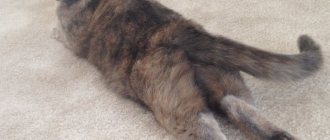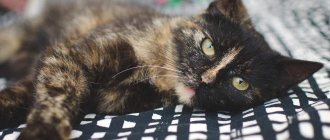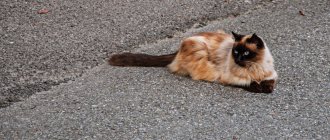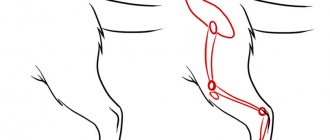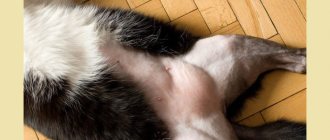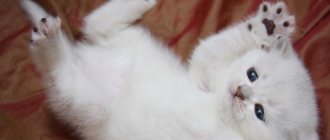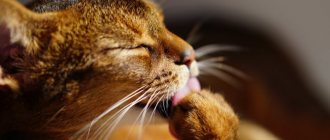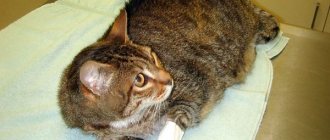Hind limb failure in a cat is a symptom that can indicate many different diseases. Often, an accurate diagnosis can only be made by a veterinarian after examination and testing. In some cases, the animal’s limbs can be restored to function if treatment is started in time.
Let's look at the reasons why a cat's hind legs may fail, how to provide first aid, basic treatment methods and possible prognoses.
Symptoms of pathology
Symptoms may vary depending on the cause of the limb failure. In most cases, the paws do not completely lose their functionality immediately.
At first, the cat may drag its hind limbs and stand on them unsteadily. Without timely treatment, the situation will worsen until the limbs are completely paralyzed. Some diseases can even lead to the death of an animal.
The following symptoms of hind limb failure in a cat can be identified:
- The animal begins to drag its hind legs.
- When walking, the limbs move apart.
- The cat may experience pain and “protect” its hind legs.
- Decreased activity, apathy.
- An increase in body temperature may indicate an inflammatory process in the body or an infection.
- Loss of sensation in the limbs.
- The cat bites its paws.
- Complete failure of the hind limbs. The cat moves only on its front legs, dragging its hind legs behind it.
What is ataxia?
Without going into details, this is the name for a set of symptoms that imply problems with coordination of movements and body position in space. There are three types of this pathology:
- Cerebellar ataxia in cats is caused by damage to the cerebellum.
- Accordingly, vestibular occurs in cases where something is very wrong with the vestibular apparatus located in the inner ear.
- Sensitive. In some ways it is similar to the cerebellar, only in this case important nerve cords are damaged.
There are different causes of ataxia in cats. Most often, the development of the disease is due to:
- Poisoning with various poisons.
- Hereditary diseases accompanied by degenerative phenomena in the nervous tissue.
- Injuries that occur especially often in March, when loving cats fall from balconies.
- Lack of vitamin B1. This is generally typical for cats: many owners “pamper” them with fresh river fish, which contains the enzyme thiaminase. It destroys thiamine, that is, B1, resulting in ataxia. This is especially noticeable in kittens.
- If the cat is “hooked” on some plants. For example, a large dose of catnip can send a cat into “nirvana” for several minutes. At this time, the pet looks like an inveterate drunkard.
- Traumatic brain injury.
- Tumor.
- Infection. In particular, feline panleukopenia is very dangerous.
- Hydrocephalus or cerebral edema.
Unfortunately, these are not all the reasons. Cerebral hypoplasia is a fairly common hereditary lesion of the cerebellum. This phenomenon develops in almost 70% of cases in kittens whose mother suffered from panleukopenia during pregnancy. In addition, it is possible that this pathology may develop with other infectious diseases that the cat picked up while in an “interesting situation.” Helminths can also help.
In very rare cases, ataxia develops due to lysosomal deficiency. There is such an intracellular organelle called a lysosome. It is needed to dispose of peroxide compounds and other nasty things. If there is something wrong with the lysosomes, all these substances begin to accumulate in the body. This pathology is extremely rare, incurable, and its prognosis is poor.
Causes of hind limb failure
Neurological disorders often lead to failure of a cat's hind legs. In most cases, only a doctor can determine the exact cause of paralysis.
Let's list a number of diseases that can lead to failure of a cat's hind limbs.
Injuries
Although cats are considered graceful creatures, they often fall from roofs or trees. An unsuccessful landing can lead to spinal injury or broken paws. Cats also sometimes get hit by cars. A dog bite or a directed blow can cause mechanical damage to the limbs and spine.
An injured animal may be in a state of shock, so immediately after the incident it will try to hide. When a limb is broken, the animal may feel severe pain when leaning on the limb. The paws may be unnaturally curved. The cat may have a dislocation, open or closed by a redissection.
Thromboembolism
This is a very dangerous disease that can lead to the death of the animal. This is when a cat's femoral artery is blocked by a blood clot (this could be a blood clot, a parasite, or air).
As a result, the limbs are deprived of oxygen supply. Tissue necrosis begins. The animal's condition is rapidly deteriorating.
In the first hours, the following symptoms can be observed:
- anxiety;
- meowing in pain;
- the animal does not allow you to touch the sore area (scratches, bites).
Gradually, the paws completely fail, they become cold. Apathy begins. The cat doesn't eat or drink. Death usually occurs within 2-3 days. You can save an animal if you consult a doctor in the first hours after an artery is blocked by a blood clot.
Dysplasia
This disease most often occurs in large cats (Maine Coons), but smaller breeds are also genetically predisposed to it: Siamese, Persian, Norwegian forest cat, British, Scottish.
We recommend the article: Why do wounds appear on a cat’s tail?
In most cases, this disease is congenital. It becomes most noticeable during the period of active growth of the kitten. With dysplasia, excessive formation of connective tissue occurs, the joint becomes too mobile. The animal experiences pain while moving.
Main symptoms:
- unsure gait;
- decreased activity;
- when resting, the cat stretches its paws rather than tucking them under itself;
- when walking, the animal experiences pain, and therefore tries not to strain its limbs too much;
- after the jump, the cat falls on its side and meows pitifully.
This disease is incurable. Maintenance therapy should be carried out - anti-inflammatory and painkillers should be given. Obesity should not be allowed in a sick animal, because it increases the load on sore joints.
Kidney failure
A dangerous disease that can appear in cats of all ages. It leads to disruption of the genitourinary system, as well as to a neurophysiological disorder. The functioning of the brain is disrupted.
Main symptoms:
- gradual decrease in the amount of urine;
- indigestion;
- unsteady gait, limb failure;
- increase in body temperature.
Avitaminosis
A poor diet, infection with parasites, and improper care lead to vitamin deficiency. An insufficient amount of vitamins and minerals enters the animal’s body, which causes a disruption in the development of bone and cartilage tissue.
If the animal does not receive enough sunlight, this can lead to rickets, which is often found in kittens. When it occurs, the development of bone tissue is disrupted, the limbs become bent and become fragile.
Lack of potassium leads to paresis of the limbs.
To avoid vitamin deficiency, the animal needs to be provided with a proper, complete diet. A cat that eats natural food should additionally receive vitamins.
Among ready-made food, preference should be given to premium and super-premium class. Economy class food does not contain enough minerals and vitamins.
Cardiomyopathy
Cardiomyopathy leads to an increase in the volume of the walls of the heart muscle, due to which the volume of the ventricles decreases. The heart pumps less blood. Oxygen starvation begins. The animal's limbs go numb.
Main symptoms:
- decreased activity;
- unsteady gait;
- refusal to eat;
- vomit.
Cardiomyopathy itself cannot lead to complete paralysis of the hind limbs. But because of it, thrombosis of the femoral artery can occur.
Stroke
There is a blockage of one of the blood vessels in the brain. A stroke can lead to paralysis of not only the limbs, but also all muscles. The animal may be completely immobilized.
Main symptoms:
- breathing and swallowing problems;
- severe anxiety;
- complete apathy;
- loss of sensation in the limbs;
- vomit.
Stroke is a very dangerous disease that can often lead to the death of an animal. A sick cat needs urgent medical attention. The sooner the correct diagnosis is made and measures are taken, the greater the chance of survival and recovery of the animal.
Spinal injury
The spine may be damaged due to injury or internal pathological processes.
The main sign of spinal injury is paralysis of not only the paws, but also the tail.
The animal begins to walk under itself. The sensitivity of the limbs is completely lost.
When a spinal fracture occurs, the following symptoms may occur:
- the cat's tail hung
- rapid breathing;
- loss of consciousness;
- strong heartbeat;
- decrease in body temperature.
Intervertebral hernia
A hernia forms on an intervertebral disc. An experienced doctor can detect it by palpation. The nerves are compressed, causing the animal to be unable to move its limbs normally.
We recommend the article: Lump on a cat’s back: what is it and what to do about it?
Most often, a hernia occurs in older animals. In most cases, it does not lead to complete failure of the limbs, but only to a disturbance in gait. The situation can only be corrected by surgical intervention.
Tick paralysis
The bite of ixodid ticks leads to the entry of toxic substances into the body. The disease develops very quickly.
At first, the cat begins to behave very excitedly. Afterwards, activity decreases and limbs fail. The cat stops eating and drinking and reacts poorly to stimuli. Body temperature rises greatly. Severe trembling and vomiting are possible. The animal loses consciousness and convulsions begin.
The cat can be saved only if treatment is started in time. In half of the cases when bitten by an infected tick, the animal dies.
Spinal cord inflammation
It can occur for various reasons: infection by parasites, poisoning, infection and others.
Main symptoms:
- increased body temperature;
- indigestion;
- urinary incontinence.
With timely consultation with a doctor, complete restoration of limb function is possible.
Hyperparathyroidism
Most often, hyperparathyroidism is caused by improper and unbalanced feeding of the animal. The production of hormones is disrupted. Calcium from the animal's bones enters the blood. The bones themselves become thinner and more fragile. The animal's gait is disturbed, the cat feels severe pain. The spine also becomes more fragile. Neurological functions are impaired, causing the cat's hind legs to fail.
Nerve damage during injection
Sometimes when administering an intramuscular injection, the owner or doctor may hit the sciatic nerve with a needle. This can lead to temporary impairment of the animal's paw. Often the limb returns to normal within a few days.
Cerebellar ataxia
In this case, the motor pathology was provoked either by a genetic factor with a developmental defect in the brain structures, or by a mother cat who developed panleukopenia in late pregnancy.
In kittens, hypoplasia of the cerebellum occurs, which controls coordination and regulates voluntary and involuntary movements.
The unusual nature of the kitten becomes obvious when the babies grow up and begin to move actively. And in some cases, particularly attentive owners can detect violations immediately after birth. Most cats with cerebellar ataxia move sideways or diagonally.
Cerebellar ataxia differs from other types of ataxia: nystagmus - involuntary very rapid movements of the eyes, trembling of the head when the animal is focused on something, and tremor of the back of the body during movement. When the cerebellar vermis is damaged, static-locomotor ataxia develops.
According to the severity, it can occur in mild, moderate and severe form. With mild, falls occur periodically, the cat actively walks and runs; with moderate, movements are not easy for the animal, the cat often falls, but still moves. And the severe degree does not even allow you to get up on your paws.
Unfortunately, the disease cannot be treated. But with proper care, a kitten has every chance of living as long as an ordinary healthy cat. He does not experience any pain, his intelligence is completely preserved, and after the age of 1 year, movements become more coordinated and consistent. If deterioration begins, this only indicates that another neurological disease with similar symptoms has joined the ataxia.
By nature, cats with cerebellar ataxia are very affectionate and friendly. Owners of such animals note their unusual intelligence, close emotional connection and strong affection. Throughout its life, a cat perceives its owner or mistress as a big mother.
Reference!
The same litter may produce kittens with varying degrees of cerebellar damage.
First aid at home
If the hind limbs fail, the cat should be seen by a doctor as soon as possible. First of all, you need to take the following measures:
- If the animal is panicking, it should be calmed down. You can talk to the cat in a gentle voice, stroke its head. It is important that the animal moves as little as possible.
- If trauma has led to paralysis, the cat must be fixed in one position. This should be done carefully so that the cat does not get nervous and try to escape. There should be a hard, hard surface underneath the animal. All movements should be kept to a minimum.
- If your limbs start to get cold, you can put a heating pad under them. It should not be very hot to avoid burns.
- If the animal is vomiting severely, the cat should be placed on its side so that the vomit does not clog the airways.
- If the cat has definitely not been injured, it can be placed on a soft surface (put a blanket in the carrier).
You need to take your animal’s veterinary passport with you to the clinic. Disposable diapers and clean napkins will not hurt. If it is cold outside, the animal should be covered.
Diagnostics
There can be many reasons for hind leg failure in cats. If the owner himself has not witnessed the injury that the cat received, a large-scale diagnosis will have to be carried out.
At the clinic, the veterinarian will conduct the following tests:
- Take a general urine and blood test. They can be used to determine the presence of inflammatory processes in the body.
- Conducts an external inspection. Test the sensitivity of the limbs and reflexes.
- Take an x-ray of the spine. It shows the presence of fractures, tumors, and dislocations.
- It is possible to take an x-ray using contrast fluid.
- If an infection is suspected, the doctor may take a bacterial culture.
- If damage to internal organs is suspected, the doctor will perform an ultrasound.
- If necessary, an MRI of the brain and spine can be done.
We recommend the article: Dermatitis in cats: causes, types, treatment
Vestibular ataxia
The diagnosis is made in two cases: with an affected structure of the inner ear and with tumors of the brain stem or medulla oblongata.
Adult animals over 10 years of age are most susceptible to the disease. The cat has difficulty standing, can walk in circles, or fall over on one side.
The head is either thrown back or tilted towards the affected side. Movements are slow and careful. Concomitant strabismus and nystagmus are often found, and in some cases there is also periodic vomiting.
The appearance of vestibular ataxia is provoked by:
- otitis;
- brain tumors;
- bacterial infections and abscesses of the ear canal;
- excessively intense and traumatic ear cleaning;
- medication overdose;
- use of aminoglycoside antibiotics;
- liver or kidney dysfunction (in rare cases).
Attention!
A cat with an affected vestibular apparatus may periodically sit in a corner with its forehead pressed against the wall. We often see this exact pose of the animal in a series of “funny” photos. Meanwhile, the pet is suffering from a severe headache and is in dire need of veterinary care.
Treatment and care
As a result of a comprehensive study, the doctor will give the animal a diagnosis, on which the further treatment plan will depend.
Depending on the disease that caused the paw failure, the following treatment methods for the cat are possible:
- Conservative.
- Operational.
- Physiotherapy.
Conservative method
Most diseases in the early stages can be cured with medication. If an infection is detected, the cat is prescribed antibiotics.
For dysplasia, painkillers and anti-inflammatory drugs are used. In some cases, drug treatment is effective against blood clots.
When a tick bites, antibiotics, diuretics and anticonvulsants are prescribed.
Often the animal is prescribed a diet. It is especially important to follow it if a cat is diagnosed with vitamin deficiency. In this case, vitamin-mineral complexes are also additionally prescribed.
It is important to control the weight of animals that suffer from hip dysplasia or arthritis. Obesity leads to deterioration of the cat's condition.
Surgery
Surgeries are performed in cases of closed and open spinal fractures. Surgical intervention is necessary to remove intervertebral hernias and neoplasms. It is also effective in case of blockage of blood vessels by a blood clot.
Rehabilitation and physiotherapy
Often, in order to restore mobility to paralyzed limbs, the animal must undergo a course of physical therapy. It should only be used as prescribed by a doctor. Otherwise, physical activity may worsen the animal's condition.
Often during rehabilitation the animal is prescribed a special massage. There are also a number of exercises that the owner should do with his pet:
- The paws can be developed using the “bicycle” exercise. Use your hands to carefully move your limbs back and forth.
- You should stroke and tickle the paw pads several times a day.
- Place a towel under the cat's belly. You need to take it by both ends and carefully lift the animal. The cat will try to walk forward by moving its hind legs.
Risk factors
There are several predisposing factors that can cause poor coordination and motor activity in a cat's hind legs. It is important to analyze them and understand what could have caused the deterioration in this case. This can facilitate diagnosis and prescribe the most appropriate treatment in a short time.
Among the common provoking factors are the following:
- Getting injured
. Very often, after an unsuccessful jump or fall, even from a small height, damage of varying severity can occur. Most people believe that cats can catch themselves in a split second when falling, but this is not always the case. The consequences of an injury can be visible immediately, or they can appear after a certain time, so you need to remember if similar incidents have happened recently.
- Breed predisposition
. Some cat breeds are at risk for certain diseases that can cause corresponding alarming symptoms. Hypoglycemia is considered a common problem for the Burmese breed. Chartreux and Maine Coons often have hip dysplasia, and Cymrics are considered a breed with congenital weakness in the hind legs. Such difficulties are the price to pay for artificially bred beauty and manipulation of genes carried out by breeders. - Inflammatory processes and infections
. They can affect any organ or organ system, but at different stages give complications in the form of impaired motor ability of the hind legs. In such cases, the fact that the cat walks poorly is not the only sign of illness. - Violation of metabolic processes
. Often, a deficiency of important vitamins leads to paralysis of the paws. The reason for this may be both metabolic disorders and improper nutrition of the animal.
This is interesting: Intestinal lymphoma in a cat
Physiotherapy for cats with leg paralysis
The recovery period after paralysis drags on for a long time; in this case, the animal owner cannot do without physiotherapy.
Veterinarians advise performing a daily set of exercises to help restore neurological functions.
- Passive movements. Place the cat on its back and move the paralyzed legs alternately in a circular motion for at least five minutes. The exercise is similar to riding a bicycle.
- Stimulating massage. Stretch your paw pads and limbs daily.
- Scratching. Scratch the paralyzed animal in different places; even with little progress, the cat will try to scratch with its hind paw.
- Using an inflatable ball. Place the cat on its stomach on the ball, so that its paws lightly touch the floor. Roll the ball while holding your pet back and forth.
- Using support. Pass a wide strip of fabric under your pet's belly and try to walk with the animal, holding the ends of the fabric.
- Moving limbs. Take the cat by the hind legs and slowly move them, imitating walking.
- Swimming. Make the cat swim in the bath every day, holding the animal so that it does not choke.
Be sure to read:
Interpretation of blood tests in cats: features of the procedure, types, main indicators, norms
General restorative home treatments for paralysis of paws
If the initial examination is not enough to determine the cause of paw paralysis, then the following diagnostic methods are used:
- determination of neurological reactions;
- X-ray of the spine and affected limbs;
- Ultrasound of the abdominal cavity;
- detailed blood and urine analysis;
- taking smears for bacteriological analysis;
- MRI and CT scans of areas of the body where pathology is suspected to exist (spine, abdominal cavity, brain);
- determining the level of sensitivity of the affected limbs.
If a cat's hind legs have failed, he will benefit from daily restorative procedures. The owner can easily work with the pet on his own at home.
- Paw massage should be done 5 to 7 times a day. For 10-15 minutes, massage your limbs with light but intense movements. This will help restore the conduction of nerve impulses and prevent the muscles from atrophying.
- Therapeutic gymnastics in the form of forced flexion and extension of the limbs is very useful.
- You can imitate walking using a kind of walker, which can be made from a wide towel placed under the cat’s belly. By supporting the animal in this way, you need to provoke it to move its paws on its own. If it is difficult for him, you can help with your hands.
- Swimming gives very good results if the cat is not afraid of water. Once in a pond or bathtub, the animal involuntarily moves its paws, trying to swim, while the owner holds it under its belly. It has been noticed that healing occurs much faster after a course of such exercises.
- Tickling the paws will help the owner feel the moment when the animal begins to feel them, by reaction to irritation.
- Exercises on the ball are effective. The cat is placed on a ball of suitable size. Her paws, hanging down, should almost touch the floor, so that when she rolls, she seems to stand on them.
If the cat’s treatment does not bring the expected effect, and it still drags its hind legs, then you should not euthanize the animal. There is a way out in this case too. There are specialized wheelchairs for cats that perform the functions of limbs. Once accustomed, the cat will be able to move quite quickly in such a stroller without the help of the owner. The quality of life of an animal when using such a device remains quite high.
General recommendations
In addition to therapeutic measures, massage of the cat’s lumbar region and hind legs is included.
- Massage of the limbs and lumbar region is indicated in order to prevent atrophy of the muscle tissue of the hind legs. Should be done every day for about ten minutes.
- Some kind of gymnastic exercises will be a good help.
- You need to imitate the walking or running movements of the animal’s limbs. It is possible to imitate primitive walkers, when the fabric supports the cat under the stomach, and the paws move quietly along the floor.
- Swimming worked well. The pet strains its paws, involuntarily moves them in the water, while the owner supports it under its belly. You can also use a small ball. Place the cat on top and roll it back and forth so that its limbs touch the floor.
Symptomatic picture
The cat owner should be alarmed by:
- lameness in one or both legs;
- unsteadiness of gait;
- the cat’s reluctance to jump and run;
- decreased activity;
- restlessness, even to the point of aggressive behavior when trying to touch the hind legs or pelvic area.
Even if one of the listed symptoms is observed, you should consult a specialist.
The importance of differential diagnosis
If a cat's hind legs fail, it is quite difficult to find out the reasons for this. There is a belief that almost all diseases can cause complications and forced limitation of movement.
If a cat does not walk, it can be difficult to distinguish between paralysis of the paws and severe pain that occurs when moving. Perhaps he, experiencing pain when walking, simply refuses to make efforts, since they bring additional discomfort. The causes of severe pain in the back or abdominal area may be the following ailments:
- urolithiasis disease;
- tumor diseases;
- inflammation of the urinary and reproductive system;
- intestinal obstruction.
A distinctive feature of these diseases is that the cat’s paws retain full sensitivity and nerve conduction is not impaired.
Forecast
Most diseases can be completely cured only in the first stages. That is why at the first symptoms of a cat’s disease, it must be urgently shown to a doctor. In this case, the chance of getting the animal back on all four paws is very high.
Damage to the spine and spinal cord often leads to complete paralysis of the hind limbs and tail. The animal may begin to walk under itself. You may have to order a special stroller with which the cat can move around again.
Infectious diseases are very dangerous. Without timely assistance, they can kill an animal in a couple of days. If treatment began before the body underwent serious pathological changes, the likelihood of a complete cure is very high.
There are also incurable diseases - hip dysplasia, congenital osteochondrodysplasia, arthritis. They will have to undergo maintenance therapy. During periods of exacerbation, the animal may feel severe pain. You will have to keep your pet on a diet, and also constantly show it to the doctor to monitor the condition.
Thus, failure of the hind limbs in a cat is a serious symptom that can indicate many dangerous diseases. Only a doctor can make an accurate diagnosis.
The most effective treatment is only in the first stages of the disease. This is why it is so important to show your pet to a doctor when the first symptoms of paw failure appear.
I love cats very much and worry about them like children when they are sick.
Veterinarian by first education, graduated from the Moscow State Academy of Veterinary Medicine and Veterinary Medicine.
